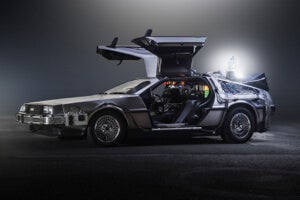It’s officially 2015, the year Marty McFly and Doc Brown visited in their souped up DeLorean time machine in Back to the Future Part II. There’s been a flurry of press comparing the iconic flick’s predictions to reality—and it got me thinking.
Let’s say Robert Zemeckis is making the movie today. He and cowriter Bob Gale are researching current trends in technology and projecting thirty years into the future. What vision do you think would emerge?

Back to the Future II got a few things right or nearly right. A drone, for example, snaps a picture of Griff Tannen’s arrest for USA Today. Drones for personal use, specifically photography, are just now beginning to take off. And while they aren’t walking dogs (as they do in another scene), they may soon deliver stuff to your door.
As the McFlys sit down to eat a rehydrated pizza—nowhere in sight, thank god—Marty’s daughter watches TV and answers the phone on a pair of glasses. Google Glass is already available to developers and may launch to consumers in 2015. Are they identical? Nope. But close enough in design and functionality to call it a hit.
Other near hits include biometrics and mobile payment (iPhone and Apple Pay), big flatscreen TVs (though we don’t use them as windows), voice command, and electronics in everything from trash cans to locks (we’re nearly there). Smart clothes with built-in sensors and chips are here, and Nike is releasing special edition high tops with power laces.
The film also got some things pretty wrong. It completely missed smartphones and tablets. And while it included a network of computers (the proto-internet was already underway in the 80s), they hooked the McFlys’ terminal up to a fax machine.
Perhaps most obviously, we don’t have hoverboards, flying cars (the closest are more like roadable planes) or fusion in any form—let alone compact units that fit in the trunk of a car and run on garbage. (If only!)
Way back in the 80s, when Back to Future II premiered, its vision of 2015 actually felt pretty futuristic. In reality, 2015 feels both more and less advanced than predicted. And really, at a glance, it doesn’t look that different.
But let’s not kid ourselves. It is a lot different. And getting more different at an accelerating pace. So, what 2015 technologies will be fully developed by 2045, which ones will go the way of the dodo (perhaps unexpectedly), and which might take us completely by surprise (maybe they exist but are vastly underrated)?
Leave your forecasts in the comments, and we’ll reconvene in three decades to compare notes. (Also, check out this Wiki for a more complete list of the technologies featured in the film.)
Image Credit: Oto Godfrey/Wikimedia Commons



